The African Queen (film)
9 /10 1 Votes
100% Rotten Tomatoes Genre Adventure, Romance, War Duration Language English | 7.9/10 IMDb Story by C. S. Forester Country United StatesUnited Kingdom | |||||||||||||||||||||||||||||||||
 | ||||||||||||||||||||||||||||||||||
Release date December 23, 1951 (1951-12-23) Writer C.S. Forester (novel), James Agee (adapted for the screen by), John Huston (adapted for the screen by) Initial release December 23, 1951 (Los Angeles) Cast (Charlie Allnut), (Rose Sayer), (Rev. Samuel Sayer), (Captain of Louisa), (First Officer), (Second Officer) Similar movies Independence Day , Rambo , City of Angels , Dominion: Prequel to the Exorcist , A Mighty Heart , The Reaping Tagline The greatest adventure a man ever lived...with a woman! | ||||||||||||||||||||||||||||||||||
The african queen 1951 trailer
The African Queen is a 1951 British-American adventure film adapted from the 1935 novel of the same name by C. S. Forester. The film was directed by John Huston and produced by Sam Spiegel and John Woolf. The screenplay was adapted by James Agee, John Huston, John Collier and Peter Viertel. It was photographed in Technicolor by Jack Cardiff and had a music score by Allan Gray. The film stars Humphrey Bogart (who won the Academy Award for Best Actor – his only Oscar), and Katharine Hepburn with Robert Morley, Peter Bull, Walter Gotell, Richard Marner and Theodore Bikel.
Contents
- The african queen 1951 trailer
- Plot
- Cast
- Production
- Premiere
- Others
- Subsequent releases
- 2009 digital restoration
- Adaptations to other media
- References

The African Queen was selected for preservation in the United States National Film Registry in 1994, with the Library of Congress deeming it "culturally, historically or aesthetically significant". The film currently holds a 100% "Fresh" rating on Rotten Tomatoes, based on 37 reviews.
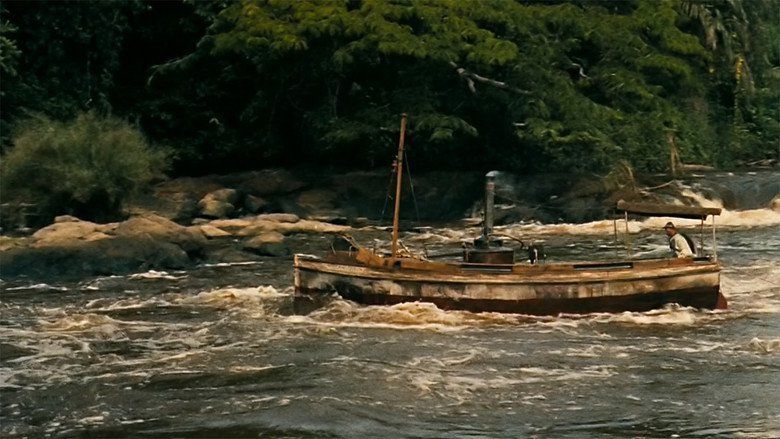
Plot
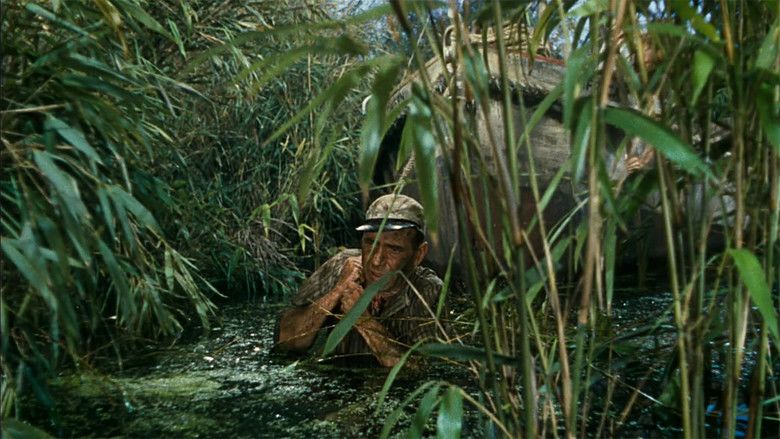
Samuel Sayer (Robert Morley) and his sister Rose (Katharine Hepburn) are British Methodist missionaries in the village of Kungdu in German East Africa at the beginning of World War I in August/September 1914. Their mail and supplies are delivered by a small steam launch named the African Queen, helmed by the rough-and-ready Canadian boat captain Charlie Allnut (Humphrey Bogart), whose coarse behavior they tolerate in a rather stiff manner.
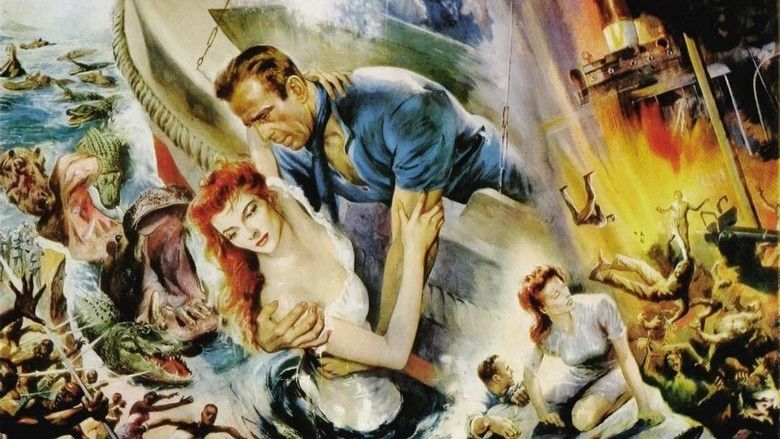
When Charlie warns them that World War I has broken out between Germany and Britain, the Sayers choose to stay on, only to witness the Germans burn down the mission village and herd the villagers away. When Samuel protests, he is beaten by a German soldier. After the Germans leave, Samuel becomes delirious with fever and soon dies. Charlie returns shortly afterward. He helps Rose bury her brother, and they set off in the African Queen.
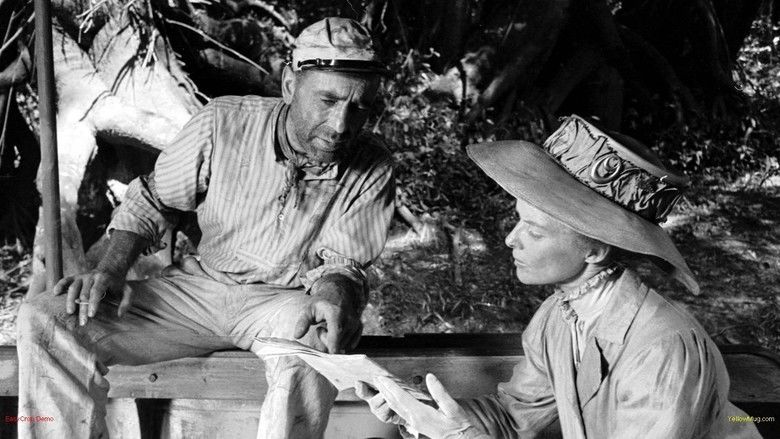
Charlie mentions to Rose that the Germans have a gunboat, the Königin Luise ("Queen Luise"), which patrols a large lake downriver, effectively blocking any British attacks. Rose comes up with a plan to convert the African Queen into a torpedo boat and sink the Königin Luise. Charlie points out that navigating the Ulanga River to get to the lake would be suicidal: to reach the lake they would have to pass a German fort and negotiate several dangerous rapids. But Rose is insistent and eventually persuades him to go along with the plan.
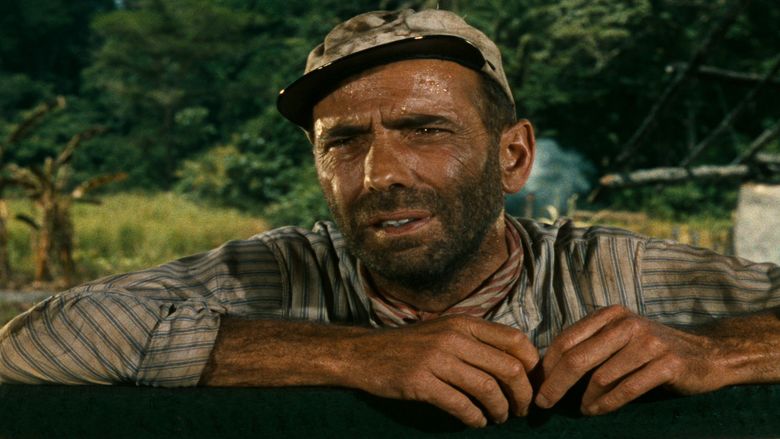
During their journey down the river, Charlie, Rose and the African Queen encounter many obstacles, including the German fort and three sets of rapids. The first set of rapids is rather easy; they get through with minimal flooding in the boat. But when they pass the fortress and the soldiers begin shooting at them, the bullets pierce the top of the boiler and cause one of the steam pressure hoses to disconnect from the boiler. This causes the boat's engine to stop. Luckily, Charlie manages to reattach the hose to the boiler just as they are about to enter the second set of rapids. The boat rolls and pitches crazily as it goes down the rapids, leading to more severe flooding in the boat. However, they make it through.
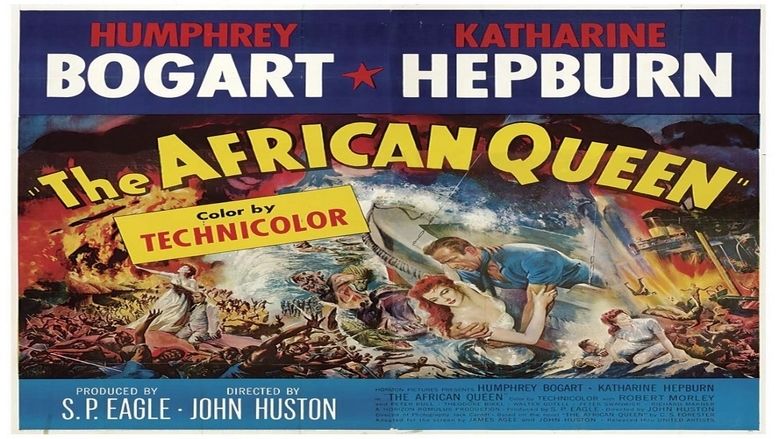
While celebrating their success, the two find themselves in an embrace. Embarrassed, they break off, but eventually succumb and strike up a relationship. The third set of rapids comes up. This time, there is a loud metallic clattering noise as the boat goes over the falls. They dock on the river bank to check for damage. When Charlie dives under the boat, he finds the propeller shaft hopelessly twisted "like a cork screw" and a blade missing from the propeller. At first defeated, Charlie is finally roused by Rose's technically naive but determined prodding. Rigging up a simple forge on shore, he straightens the shaft while Rose works the makeshift bellows, welds a new blade onto the prop, and they are off again.
All appears lost when Charlie and Rose "lose the channel" and the boat becomes mired in the sprawling delta's islets and mud amid dense reeds near the mouth of the river. First, they try to tow the boat through the muck, only to have Charlie come out of the water covered with leeches. All their efforts to free the African Queen fail. With no supplies left and short of potable water, Rose and a feverish Charlie turn in, convinced they have no hope of survival. Before going to sleep Rose prays that she and Charlie be admitted into Heaven. As they sleep, exhausted and beaten, heavy rains falling upstream raise the river's level and float the African Queen off of the mud and into the lake which, it turns out, is just a short distance from their location. Once on the lake, they narrowly avoid being spotted by the Königin Luise. The Königin Luise departs, but Charlie believes that she will return as she makes her normal rounds of the lake.
Over the next two days, Charlie and Rose convert some oxygen cylinders into torpedoes using gelatin explosives and improvised detonators that use nails as the firing pins for rifle cartridges. They then push the torpedoes through holes cut in the bow of the African Queen as improvised spar torpedoes. The Königin Luise returns as Charlie predicted, and Charlie and Rose steam the African Queen out onto the lake in darkness, intending to set her on a collision course with the Königin Luise before diving overboard and making their way to safety to "Keenya" on the east side of the lake. A strong storm strikes as they head toward the Königin Luise. Unfortunately, the torpedo holes they cut are not sealed, which allows water to pour into the African Queen, causing her to sink lower and lower. Eventually the African Queen capsizes, throwing them both into the water. Charlie loses sight of Rose in the storm.
Charlie is captured and taken aboard the Königin Luise, where he is questioned by the captain. Believing Rose to have drowned, he makes no attempt to defend himself against accusations of spying, and the German captain sentences him to death by hanging. However, Rose is captured and brought to the Königin Luise just after Charlie's sentence is pronounced. Charlie hollers her name in excitement that she is actually alive, but then tries to protect her by pretending not to know her. The captain questions her, and Rose confesses the whole plot proudly, deciding they have nothing to lose anyway. The captain sentences her to be executed as a spy, too. Charlie asks the German captain to marry them before executing them. After a brief marriage ceremony, the Germans prepare to hang them, but there is a sudden explosion and the Königin Luise quickly capsizes and sinks. The Königin Luise has struck the overturned hull of the African Queen and detonated the torpedoes, still attached. Their plan has worked after all, if a little belatedly, and the newly married couple happily swims to safety on the east shore of the lake as the surviving Germans appear to make no effort to re-capture or shoot at them.
One glaring logical error: in the film, unlike the book, the big debate about whether to continue downstream or not occurs AFTER the rapids, not before. Of course, at that point their choices were limited to going on or staying put. It would have been impossible to return.
Cast
Production
Production censors objected to several aspects of the original script, which included the two characters cohabiting without the formality of marriage (as in the book). Some changes were made before the film was completed. Another change followed the casting of Bogart; his character's lines in the original screenplay were rendered with a thick Cockney dialect but the script had to be completely rewritten because the actor was unable to reproduce it. The rewrite made the character Canadian.
The film was partially financed by John and James Woolf of Romulus Films, a British company. Michael Balcon, Honorary Adviser to the National Film Finance Corporation, advised the NFFC to refuse a loan to John Woolf’s The African Queen (1952) unless it starred John McCallum and Googie Withers, rather than Humphrey Bogart and Katherine Hepburn as Woolf wanted. This was clearly partial as he was favouring his former Ealing Studio actors. It was only because of Woolf’s personal intervention that he persuaded the chairman of the NFFC, Lord Reith to overrule Balcon and the film went ahead. The Woolf brothers provided £250,000 and were so pleased with the completed movie that they talked John Huston into directing their next picture, Moulin Rouge (1952).
Much of the film was shot on location in Uganda and the Congo in Africa. This was rather novel for the time, especially for a Technicolor picture which utilized large unwieldy cameras. The cast and crew endured sickness, and spartan living conditions during their time on location. In one scene, Hepburn was playing an organ but had a bucket nearby because she was often sick between takes. Bogart later bragged that he and Huston were the only ones to escape illness, which he credited to not drinking any water on location, but instead fortifying themselves from the large supply of whiskey they had brought along.
About half of the film was shot in Britain. For instance, the scenes in which Bogart and Hepburn are seen in the water were all shot in studio tanks at Isleworth Studios, Middlesex. These scenes were considered too dangerous to shoot in Africa. All of the foreground plates for the process shots were also done in studio.
A myth has grown that the scenes in the reed-filled riverbank were filmed in Dalyan, Turkey. But Katharine Hepburn's published book (p. 118) on the filming states 'We were about to head... back to Entebbe, but John [Huston] wanted to get shots of Bogie and me in the miles of high reeds before we come out into the lake...". The reeds sequence was thus shot on location in Africa (Uganda and Congo) and London studios.
Most of the action takes place aboard a boat – the African Queen of the title – and scenes on board the boat were filmed using a large raft with a mockup of the boat on top. Sections of the boat set could be removed to make room for the large Technicolor camera. This proved hazardous on one occasion when the boat's boiler – a heavy copper replica – almost fell on Hepburn. It was not bolted down because it also had to be moved to accommodate the camera. The small steam-boat used in the film to depict the African Queen was built in 1912, in Britain, for service in Africa. At one time it was owned by actor Fess Parker. In December 2011, plans were announced to restore the boat. Restoration was completed by the following April and the African Queen is now on display as a tourist attraction at Key Largo, Florida.
Because of the dangers involved with shooting the rapid scenes, a small-scale model was used in the studio tank in London.
The vessel used to portray the German gunboat Königin Luise in the film was the steam tug Buganda, owned and operated on Lake Victoria by the East African Railways and Harbours Corporation. Although fictional, the Königin Luise was inspired by the German First World War vessel Graf Goetzen (also known as Graf von Goetzen), which operated on Lake Tanganyika until she was scuttled in 1916 during the Battle for Lake Tanganyika. The British refloated the Graf Goetzen in 1924 and placed her in service on Lake Tanganyika in 1927 as the passenger ferry MV Liemba, and she remains in active service there as of 2015.
The name 'SS Königin Luise' was taken from a German steam ferry which operated from Hamburg, before being taken over by the Kaiserliche Marine on the outbreak of the First World War. She was used as an auxiliary minelayer off Harwich before being sunk on 5 August 1914 by the HMS Amphion (1911).
A persistent rumour regarding London's population of feral Ring Necked Parakeets is that they originated from birds escaped or released from the filming of this movie, however this claim is considered dubious.
Premiere
The African Queen opened on December 23, 1951 in Los Angeles, in order to qualify for the 1951 Oscars, and on February 20, 1952 at the Capitol Theatre in New York City.
The film earned an estimated £256,267 at UK cinemas in 1952, making it the 11th most popular movie of the year. It earned an estimated $4 million at the US and Canadian box office.
Others
American Film Institute recognition
AFI has also honored both Humphrey Bogart and Katharine Hepburn as the greatest American screen legends.
Subsequent releases
The film has been released on Region 2 DVD in the United Kingdom, Germany and Scandinavia.
The British DVD includes a theatrical trailer and an audio commentary by cinematographer Cardiff in which he details many of the hardships and challenges involved in filming in Africa.
Prior to 2010, the film had been released in the United States on VHS video, laserdisc and as a region 1 DVD. Region 1 and Region All DVDs are available and distributed by The Castaways Pictures, and have English and Chinese subtitles available with no other features. It is not clear if these are authorized or not.
2009 digital restoration
In 2009, Paramount Pictures (the current owner of the US rights) completed restoration work for region 1 and a 4K digitally restored version was issued on DVD and Blu-ray March 23, 2010. The film was restored in its original mono soundtrack from original UK film elements under the sole supervision of Paramount, and had as an extra a documentary on the film's production, Embracing Chaos: The Making of The African Queen. According to Ron Smith, vice president of restoration for Paramount Pictures, the major factor that led to the holdup were difficulties locating the original negative. Romulus Films and international rights holder ITV Global Entertainment were acknowledged in the restoration credits.
ITV released the restoration in Region 2 on June 14, 2010.
Adaptations to other media
The African Queen was adapted as a one-hour radio play on the December 15, 1952 broadcast of Lux Radio Theater with Humphrey Bogart reprising his film role and joined by Greer Garson. This broadcast is included as a bonus CD in the Commemorative Box Set version of the Paramount DVD.
A 1977 television film continued the adventures of Allnut and Sayer, with Warren Oates and Mariette Hartley in the lead roles. Though intended as the pilot for a series, it was not picked up.
An elliptic commentary on the making of The African Queen can be found in the 1990 film White Hunter Black Heart, directed by Clint Eastwood.
The African Queen was part of the inspiration for the Jungle Cruise attraction at Disneyland in California. Imagineer Harper Goff referenced the African Queen frequently in his ideas; even his designs of the ride vehicles were inspired by the steamer used in the film.
References
The African Queen (film) WikipediaThe African Queen (film) IMDbThe African Queen (film) Rotten TomatoesThe African Queen (film) themoviedb.org
